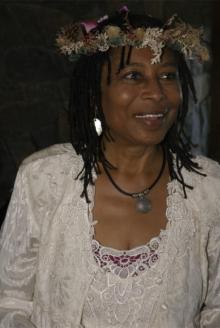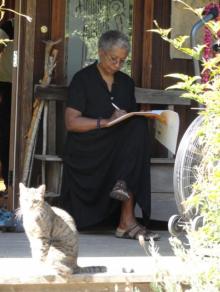- Home
- Alice Walker
Living by the Word Page 3
Living by the Word Read online
Page 3
Next morning, when I called the prison, a black woman, her accent unmistakable, answered the phone. My name did not appear on the visitors’ list, she said. Besides, she continued, Dessie Woods was very “picky” about who she wanted to see. Also, Dessie and the warden were “very close,” and, in any case, Dessie was in solitary confinement and could not receive visitors.
Meanwhile, on the wall of the supermarket where I shop in San Francisco there is a large “Free Dessie Woods!” sign scrawled in black paint. And each July 4th there are protests all over the country and in Europe, and thousands of people marching, holding aloft drawings of Dessie. In solidarity with them I write congressmen, the governor of Georgia, and Rosalyn Carter, knowing the effort is futile as I make it. The news from inside Hardwick is horrifying: Dessie is forced to remain nude in an unheated cell for long periods; she is psychologically brutalized by prison officials; and, most terrifying of all, she is being forced to take a powerful tranquilizer, which also could have serious side effects, called Prolixin.
A year after this first attempt to see Dessie, I enlist the aid of a woman who knows her lawyer. Since the lawyer lives in Chicago and rarely gets to Georgia, I agree to go for him, as his paralegal, to collect information from Dessie about her upcoming appearance before the prison parole board. He calls the prison this time, informs the officials I’m coming, and, in a matter of days, I am once again in the air.
On my way to Hardwick I stop in Atlanta to address members of the Georgia Alliance for Prison Alternatives. These are all strongly committed movement-oriented folk who are opposing the construction of a new $16,000,000 prison for women in the state of Georgia. I discover, to my horror, that seventy percent of all imprisoned women are black (and that one out of every four black men is in prison). The women are usually imprisoned for petty, even pathetic crimes: for stealing food or clothing or school supplies for their children, or for cashing continually bouncing checks, which they use to buy groceries. One woman, I am told, was imprisoned for stealing a can of Vienna sausage.
The Georgia Alliance considers it a waste of taxpayers’ money to build a new prison to hold the women hit hardest by the country’s economic decline. It proposes day fines or community service in place of imprisonment, thus permitting women to remain with their children, who otherwise become burdens on their relatives or on the state. Near the end of the session a woman comes forward to speak of the missing and murdered black children of Atlanta. She says that many of the children have no one to look after them, and are not even missed until their bodies are found. She says one father recognized his son’s sneaker on TV. I am told by another woman, who knows the family, that Dessie Woods’s teen-age children live in a condemned house, in poverty, with Dessie’s old and ill mother, and that Dessie’s daughter frequently runs away.
Before leaving Atlanta I accept an invitation to read poetry at a halfway house for women from Hardwick. I am told the “strange” story of Linda Rogers, a twenty-six-year-old white woman who, the women believe, was murdered by the prison doctor. She was given the same “medication” regularly given to Dessie Woods, Prolixin. She died alone in her solitary-confinement cell on February 13, 1979. She was in prison for making “harassing” phone calls.
This time I do not call ahead. I drive directly to the prison, stopping in Eatonton only long enough to tell my own old and ill mother where I am going.
Years ago, in the mid-seventies, I had visited the old Hardwick prison, on the outskirts of the sedate antebellum city of Milledgeville. I had read poetry, and marveled at the staggering indifference to the outside world of many of the women. It hadn’t occurred to me that they were drugged. Now, from what I have learned about Hardwick prison, I feel sure they were. It was night when I visited, and therefore I remembered little about it, except that it was ugly, worn, and very overcrowded. The new one, built to accommodate the steadily rising numbers of women imprisoned, and itself overcrowded practically from the day it opened, looks like a junior college. With soft-yellow brick buildings set on a hill far off the main road, it seems desolate if benign, and, in fact, no sign of human life can be seen until one is actually at the door.
I go in, briefcase in hand. And there she is. Not Dessie Woods, but the black woman (in prison-guard uniform, no less) in charge of turning Dessie’s sisters away. She is behind the thick glass that faces me as I enter the prison. Two white women and a white man are safely behind her, working at desks. Her eyes are wary and mournful as I tell her why I have come.
She calls the warden on the intercom, briefly turning her back to me. A moment later she says: “I’m sorry, but he says your name is not on the list.”
“Check again,” I say. “I am here as the paralegal of Ms. Woods’s attorney. He cleared my visit to his client. Tell the warden that.”
Again she speaks into the intercom. Then she turns to me. “He says there’s no record of anything like that,” she says. “Besides, Dessie Woods is in solitary and can’t see anyone.”
We look at each other hard. And I “recognize” her, too. She is very black and her neck is stiff and her countenance has been softened by the blows. All day long, while her children are supported by her earnings here, she sits isolated in this tiny glass entranceway, surrounded by white people who have hired her, as they always have, to do their dirty work for them. It is no accident that she is in this prison, too.
Because it is obvious that black women do not have the right to self-defense against racist and sexist attacks by white men, I realize I am in prison as well. In the prison visitors’ book, under the date November 10, 1980, I sign my name as witness to our common oppression, and add “Tried to see Dessie Woods,” as a witness for myself.
1980
Postscript
At the time that I wrote to Dessie Woods, the warden, Leland Linahan, was under pressure from Linda Rogers’s parents about their daughter’s death. In my letter to Dessie I had said I intended to try to publish my interview with her in order to bring more attention to her case. I believe the letter was confiscated, and that she never received it.
After being turned away at the prison, I called Dessie’s lawyer and received this grim news: Four days before my visit, she had appeared before the prison parole board. During the proceedings, the new acting warden (Linahan was apparently removed because of the Linda Rogers controversy) became so enraged with her that he physically attacked her and had her thrown into a solitary-confinement cell.
Meanwhile, I read in the newspapers that the proposed $16,000,000 prison for women is not being built after all. Not because of protests from the Georgia Alliance or others who object to the imprisonment of poor and black women when other alternatives are available, but because wealthy white people, who would be living some distance from the facility, did not want it in their neighborhood.
Dessie Woods was released from prison on July 9, 1981.
THE DUMMY IN THE WINDOW:
JOEL CHANDLER HARRIS AND THE INVENTION OF UNCLE REMUS
[This was originally delivered as a talk at the Atlanta Historical Society in 1981.]
About three years ago I was asked to write an essay on folklore and what it had meant in my own writing and my own development. So I thought about it, and I became very depressed—depressed, because when you think of folklore in America, you have to think of Uncle Remus and you have to think of Joel Chandler Harris. Despite this, I went to the library to begin research on Harris, partly because he lived in Eatonton, Georgia, which is my hometown. I had deliberately repressed that connection; it was really too painful to think about. And as I read his letters, collected by the wife of his son, I realized that the subject was also too painful for me to write about in an essay. So the essay is still on the shelf, but I did take some notes, and I want to share those notes with you.
Joel Chandler Harris is billed as the creator of Uncle Remus. Uncle Remus told the stories of Brer Rabbit and Brer Fox, all the classic folk tales that came from Africa and that, even now in Africa, ar
e still being told. We, too, my brothers and sisters and I, listened to those stories. But after we saw Song of the South, we no longer listened to them. They were killed for us. In fact, I do not remember any of my relatives ever telling any of those tales after they saw what had been done with them.
When Joel Chandler Harris was a young boy in the 1850s and 1860s, he went out to work as an apprentice for a newspaperman on the Turnwold Plantation. We knew this place when I was growing up as the Turner place. It now has a historical marker, and often, driving past it, I stop and look at the house—a nice, big, white Southern house—and at the marker, which tells how Joel Chandler Harris created Uncle Remus.
In Life and Letters of Joel Chandler Harris, published in 1918 by Houghton Mifflin, Harris’s daughter-in-law, Julia Collier Harris, told his story. She wrote:
When the work and play of the day were ended and the glow of the lightwood knot could be seen in the negro cabins, Joel and the Turner children would steal away from the house and visit their friends in the slave quarters. Old Harbert and Uncle George Terrell were Joel’s favorite companions, and from a nook in their chimney corners he listened to the legends handed down from their African ancestors— the lore of animals and birds so dear to every plantation negro. And sometimes, while the yellow yam baked in the ashes, or the hoecake browned in the shovel, the negroes would croon a camp-meeting hymn or a corn-shucking melody. The boy unconsciously absorbed their fables and their ballads, and the soft elisions of their dialect and the picturesque images of their speech left an indelible imprint upon the plastic tablets of his memory.
Here, too, he heard stories of runaway slaves and “patterollers.” But Joel noticed that the patrol never visited the Turner Plantation and when, during the war, vague rumors of a negro uprising began to circulate, Mr. Turner only laughed, for he claimed that “the people who treat their negroes right have nothing to fear from them.”
Thus passed the months and years at Turnwold and it was during these colorful days that the creator of “Uncle Remus,” of “Mingo,” and “Free Joe” received those vivid and varying impressions of the old regime and of the customs of its mansions and its cabins, —pictures of a period that passed away long before he became known as the creator of types rich in humor and poetry, and redolent of the soil to which they were bound by a thousand ties of love and sorrow, of bounty and privation.
She goes on to say:
The great popular success of the legends was a matter of strange surprise to their author. [This was around 1887, after Harris had published these books, these tales, of Uncle Remus.] He said, “It was just an accident. All I did was write out and put into print the stories I had heard all my life.” When asked by an interviewer if any particular negroes suggested the “quaint and philosophic character” whom he had built up into one of the monuments of modern literature, he replied, “He was not an invention of my own, but a human syndicate, I might say, of three or four old darkies whom I knew. I just walloped them together into one person and called him ‘Uncle Remus.’ ”
The daughter-in-law also writes:
Before leaving the subject of the first volume of Uncle Remus stories, I cannot refrain from quoting a paragraph of the introduction in which Father touches on the prowess of the hero Brer Rabbit, proceeding to link up his salient characteristics with the psychology of the negro. It is in reference to the almost invariable conquest of the fox by the rabbit that the author says, “It needs no scientific investigation to show why he, the negro, selects as his hero the weakest and most harmless of all animals and brings him out victorious in contests with the bear, the wolf, and the fox. It is not virtue that triumphs, but helplessness. It is not malice but mischievousness. Indeed, the parallel between the case of all animals who must, perforce, triumph through his shrewdness and the humble condition of the slave raconteur is not without its pathos and poetry.” Finally, the reader not familiar with plantation life is counseled to “imagine that the myth stories of Uncle Remus are told night after night to a little boy by an old negro who appears to be venerable enough to have lived during the period which he describes—who has nothing but pleasant memories of the discipline of slavery.”
Then she goes on to say—this wife of the son of Joel Chandler Harris: “I have been asked many times if my husband, the eldest son of the family, was the little boy of the stories. He was not. And strangely enough, Father never told these stories to his own or any other children.”
But the stories were wildly successful. They were in every household, practically, across America. And Mark Twain, in Life on the Mississippi, tells of an encounter between Harris and a group of children:
He deeply disappointed a number of children who had flocked eagerly to get a glimpse of the illustrious sage and oracle of the nation’s nurseries. They said, when they saw this man, “Why, he’s white!” They were grieved about it. So, to console them, the book was brought that they might hear Uncle Remus’ Tar-baby story from the lips of Uncle Remus himself, or what, in their outraged eyes, was left of him. But it turned out that he had never read aloud to people and was too shy to venture the attempt now.
I think I know why he did not read or tell these stories to his own children. I think I know why he never said them aloud to an audience. I think he understood what he was taking when he took those stories and when he created a creature to tell those stories. There are very few people who were slaves who have “nothing but pleasant memories of the discipline” of that institution. And to base the personality of the storyteller on such a preposterous foundation constituted a deception beyond Harris’s attempt somehow to pass himself off as a black man. As a white man, when he opened his mouth to speak as “Uncle Remus,” perhaps he felt this.
Both of my parents were excellent storytellers, and wherever we lived, no matter how poor the house, we had fireplaces and a front porch. It was around the fireplaces and on the porch that I first heard, from my parents’ lips—my mother filling in my father’s pauses and he filling in hers—the stories that I later learned were Uncle Remus stories.
The most famous Brer Rabbit tale is also the most enigmatic, the story of the tar baby. In order to catch Brer Rabbit, whom he wishes to eat, Brer Fox makes a sort of doll out of tar. (In Africa, the doll is made out of rubber, hot rubber.) Brer Rabbit sees this tar baby beside the road and tries to get it to speak to him. And it can’t, of course. In his frustration, he hits it with his hands and feet and is soon stuck fast.
Brer Fox comes out of hiding and says, “I’ve got you now.”
Brer Rabbit says, “Yeah, that’s true.” But you know Brer Rabbit is thinking all the time. When Brer Fox says perhaps he’ll cook him for dinner in a big pot, Brer Rabbit breathes a sigh of relief. “That’s fine,” says he. “For a minute I thought you were gonna throw me in the briar patch.”
Brer Fox had not thought of this. “Maybe I’ll roast you on a spit,” he says, thinking of dinner, but wanting it to be a dinner only he can enjoy.
“Hey, that’s cool,” says Brer Rabbit. “That’s a lot better than being thrown in the briar patch.”
What is this briar-patch business anyway? Brer Fox is thinking. “Maybe I’ll make rabbit dumplings,” he says, licking his chops.
“Dumplings? Delightful,” says Brer Rabbit, “just please, please, whatever you do, don’t throw me in the briar patch.”
Now we begin to suspect that Brer Fox’s hatred of Brer Rabbit is greater than his hunger. It is more important to him that Brer Rabbit suffer than that he himself be satisfied. Of course, he runs and finds the nearest briar patch and flings Brer Rabbit into it. Once unstuck from the tar baby and on the ground, Brer Rabbit laughs at Brer Fox and says, “I was born and raised in the briar patch, born and raised in the briar patch.” And he gets away.
No matter how many times I heard this story as a child, I always expected Brer Fox to be able to use this considerable intelligence to help himself, rather than expend all his energy trying to harm Brer Rabbit. But my par
ents’ point, and that of the story, was: This is the nature of Brer Fox, and a smart rabbit will never forget it.
Needless to say, my parents had never read these stories anywhere. They had come down to them orally and were passed on to their children orally. Since none of us ever read Joel Chandler Harris, we experienced his interpretation and the stories of our own folk culture in other ways.
In Eatonton, Georgia, to this day, there is a large iron rabbit on the courthouse lawn in honor of Joel Chandler Harris, creator of Uncle Remus. There is now and has been for several years an Uncle Remus museum. There was also, until a few years ago, an Uncle Remus restaurant. There used to be a dummy of a black man, an elderly, kindly, cottony-haired darkie, seated in a rocking chair in the restaurant window. In fantasy, I frequently liberated him, using Army tanks and guns.* Blacks, of course, were not allowed in this restaurant.
The second interpretation of our folklore that we experienced was the movie Song of the South, an animated story of Uncle Remus and the little white children to whom he told his tales. Our whole town turned out for this movie: black children and their parents in the colored section, white children and their parents in the white section. Uncle Remus in the movie saw fit largely to ignore his own children and grandchildren in order to pass on our heritage—indeed, our birthright—to patronizing white children, who seemed to regard him as a kind of talking teddy bear.
I don’t know how old I was when I saw this film—probably eight or nine—but I experienced it as vastly alienating, not only from the likes of Uncle Remus—in whom I saw aspects of my father, my mother, in fact all black people I knew who told these stories—but also from the stories themselves, which, passed into the context of white people’s creation, the same white people who, in my real everyday life, would not let a black person eat in a restaurant or through their front door, I perceived as meaningless. So there I was, at an early age, separated from my own folk culture by an invention.

 In Search of Our Mothers' Gardens: Prose
In Search of Our Mothers' Gardens: Prose In Love and Trouble: Stories of Black Women: Stories of Black Women
In Love and Trouble: Stories of Black Women: Stories of Black Women Anything We Love Can Be Saved
Anything We Love Can Be Saved The Color Purple
The Color Purple By the Light of My Father's Smile
By the Light of My Father's Smile The Third Life of Grange Copeland
The Third Life of Grange Copeland You Can't Keep a Good Woman Down
You Can't Keep a Good Woman Down The Temple of My Familiar
The Temple of My Familiar Possessing the Secret of Joy
Possessing the Secret of Joy We Are the Ones We Have Been Waiting For
We Are the Ones We Have Been Waiting For The Way Forward Is With a Broken Heart
The Way Forward Is With a Broken Heart Meridian
Meridian Revolutionary Petunias
Revolutionary Petunias A Poem Traveled Down My Arm
A Poem Traveled Down My Arm Once
Once Horses Make a Landscape Look More Beautiful
Horses Make a Landscape Look More Beautiful Living by the Word
Living by the Word In Love and Trouble
In Love and Trouble The Color Purple Collection
The Color Purple Collection Now Is the Time to Open Your Heart
Now Is the Time to Open Your Heart Color Purple Collection
Color Purple Collection Taking the Arrow Out of the Heart
Taking the Arrow Out of the Heart The World Will Follow Joy
The World Will Follow Joy Meridian (1976)
Meridian (1976) Absolute Trust in the Goodness of the Earth
Absolute Trust in the Goodness of the Earth In Search of Our Mothers' Gardens
In Search of Our Mothers' Gardens